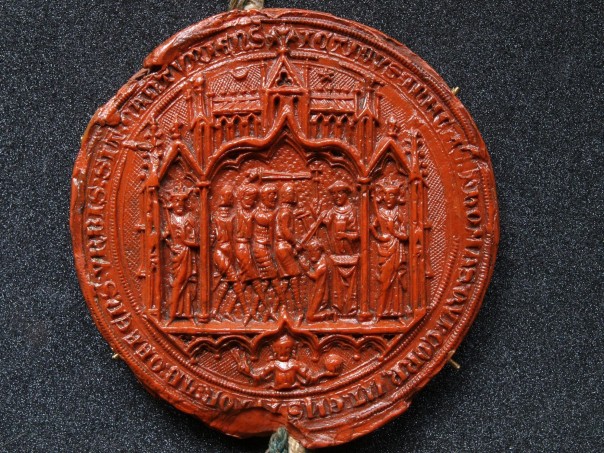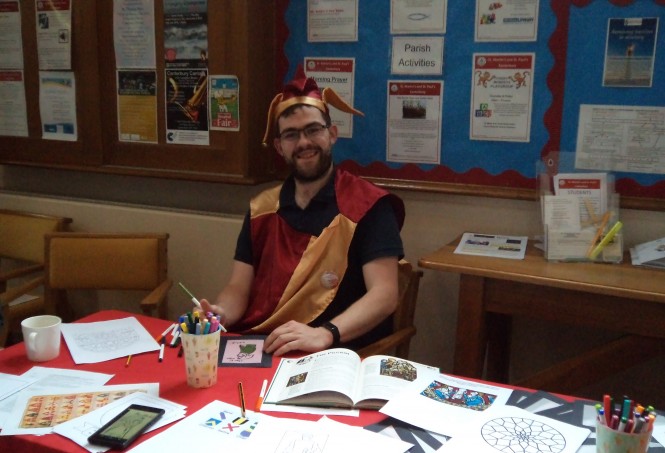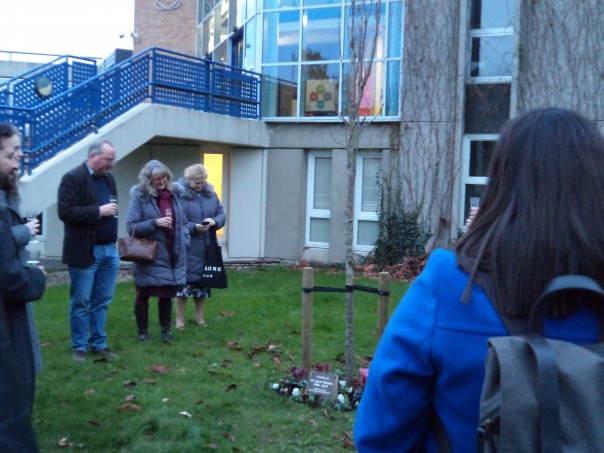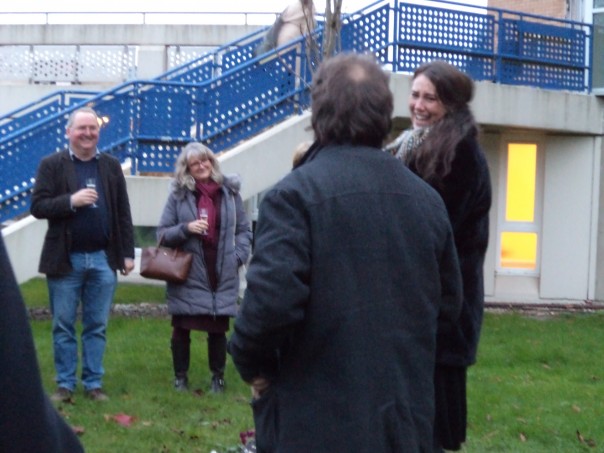This week there is information about the Centre’s future events, a report on the Kent History Postgraduate Group’s monthly research seminar and a notice about Dr Jayne Wackett’s memorial tree.

I thought this week I would leave aside Medieval Canterbury Weekend 2020 and instead mention two events that will be taking place in May and June 2020. Details, including booking, will be going up very shortly on the Centre’s ‘Future Events’ page. On 18th May, and in conjunction with Canterbury Cathedral Archives & Library and part of the Becket 2020 calendar, there will be a 1-day conference at Old Sessions, CCCU, entitled ‘Church, Saints and Seals, 1150-1300’ that will combine presentations by experts, such as Professor Markus Späth (University of Cologne), on seals with a visit to the Cathedral Archives and Conservation Studio. Speakers, including Professor Sandy Heslop (University of East Anglia) and Dr Paul Dryburgh (The National Archives), will discuss the iconography of seals, including representations of sacred buildings and Becket’s murder, as well as the materiality of seals and sealing practices.
Then on Friday 19th June there will be an open lecture by Dr Claire Bartram, an expert in early modern book culture, on Christopher Marlowe’s Kent. This will be an opportunity to celebrate Claire’s edited collection: Book Culture in Provincial Communities: Contexts for Reading and Writing 1450-1650 that is due to be published earlier in 2020. The second event in this exploration of Marlowe and 16th-century botany will take place on Saturday 20th June as a half-day conference on ‘Natural History of the 16th Century and the Works of Marlowe’. The day will start with a guided visit to Canterbury Cathedral Archives & Library before participants move to Old Sessions House, CCCU, where they will hear talks by speakers including Professor Howard Thomas (University of Aberystwyth) and Rae Granville, on contemporary ideas about plants and their importance in 16th-century society. The event is another collaborative venture, this time between the Centre and the Marlowe Statue Project group.

These are for the future, but this week we had a fascinating couple of presentations as part of the monthly Kent History Postgraduate Group’s series of research seminars. The group also welcomed back Lily Hawker-Yates who submitted her thesis a couple of months ago and is now waiting for her viva. In the meantime, she is giving several conference papers and it was these – papers at London and Exeter, which meant she was in Canterbury. Often these seminars feature the research findings of the doctoral students but this week both Janet Clayton and Dean Irwin were focusing much more on process. In Janet’s case this was an assessment of her interdisciplinary approach, while Dean considered the most productive way to categorise the English sources on medieval Jews.
Janet was our first speaker and her title was ‘Ruxley Hundred, 1200–1350: using “stuff” as evidence for status and trade’ because she wanted to show how she is seeking to use material culture, that is documentary sources about things alongside things themselves, as found during archaeological excavations or as standing buildings. For, as she said, the documentary sources, such as lay subsidy returns, inquisitions post mortem and extents of debt, while they can be useful need to be deployed carefully because each source has limitations. Of these three types, as regular readers of the blog will know, Janet has found the lay subsidies valuable, especially the exceptionally rich 1301 subsidy for this Hundred. Yet, as earlier researchers (Willard and Glasscock) have pointed out, as well as issues of coverage, standardisation and accuracy, it is important to think about values of goods in relative not absolute terms. Moreover, the assessors were not seeking to record all a householder’s goods but those deemed as surplus, albeit we don’t know where they placed their threshold. So with these caveats in mind, Janet then took her audience through the various archaeological excavations that have taken place in the last eighty years in Ruxley Hundred. To these she added Joydens Wood, which is just over the Hundred boundary, because according to Kent Archaeological Society reports from the 1950s there should be a considerable pottery collection somewhere, perhaps at Maidstone, albeit Janet has yet to locate it. Indeed, both published and unpublished KAS reports, and the finds themselves may prove to be very useful once located but at the moment in terms of the actual “stuff”, her own local archaeological group [ODAS] has been the most fruitful (the work on Scadbury Manor) for her research, supplemented by some finds from other sites in the local museum.

To try to bring some order to this mix of sites and finds, and to explore issues respecting relative personal/household wealth, social status, craft identification, residence versus non-residence and the degree or otherwise of links to London and elsewhere, Janet has been examining objects under three headings: metal, ceramics, and stone. Taking metal first, she has been using six categories of which one is ‘iron and steel’ – nails, iron for tools, steel for the edge of spades – and perhaps one of the most exciting finds she has for this is the weeding hook from Scadbury. Moving on to ceramics, London-type ware has been found at Scadbury and Joydens Wood (12th century and early 13th century). Yet this may be less evidence of direct links to London and instead may represent this type of ware produced at Plumstead, which was then sold through the more local market system. Stone, too, may be equally deceptive, but also instructive, as evidence of commerce and the transport infrastructure because whereas the River Cray is often said to have been navigable at this time, Janet’s evidence points to transport of such items as millstones to Dartford by water and then by road to Bexley.
As you can imagine, Janet’s detailed exploration of the value of material culture for her research provoked several questions, comments and suggestions before we moved on to Dean Irwin’s presentation. Having just return from a research trip to the archives in Gloucester, which he had found interesting in terms of quality if not quantity of material, Dean has been considering how best to rationalise the English sources for the Jews, not least because most in this field seem to concentrate on one modern archive: Westminster Abbey or The National Archives, rather than thinking about the contemporary context of the production of the documents that relate to the medieval English Jewry. Consequently, his four categories are: royal, civic, ‘private’, and ecclesiastical.

I’m going to keep this brief because Dean has given presentations on the first two categories in the past and summaries of these are in earlier blogs. Starting with the royal records, Dean pointed out the rolls of the Exchequer of the Jews and the value of say the assize rolls because they record at the top those present, while the receipt rolls show what the Jews had to pay to the Crown. Such rolls were produced at Westminster or if the king was elsewhere, then they were written up there.
Dean’s civic category is similarly very large because this second level of administration, the archaea (chests) in the various towns across England held copies of financial transactions involving Jews, the chirographers often included clerks used by the town to draw up civic documents. These chirographs are especially valuable for not only do they give details about the parties involved in the debt case, but they include witness lists – leading men within both the Jewish and Christian local communities. Furthermore, there is a link between the civic and royal categories, the Crown sending orders to the chirographers of the archaea, requiring that the archaea be sent to London.

Moving to Dean’s other two categories, his ‘private’ is small but as he said does contain a few very valuable sources, such as 12 documents at Hereford that involve the religious house’s purchase of Jewish debts which it then sought to enforce. Similarly, his last category brings in the Church, but more specifically the church courts and episcopal decrees. Like Janet’s presentation, Dean’s drew questions from his fellow postgraduates and then we almost finished the mince pies and ginger (courtesy of Lily) after another excellent seminar.

Finally, I want to mention an event that took place yesterday at the University of Kent in the garden just outside the front of Rutherford College. As readers of the blog may remember, Dr Jayne Wackett’s funeral at Wye is recorded in a blog from earlier this year, as is her and her husband Dr Alec Forsyth’s (CCCU) major contribution to the success of the Centre’s ‘Garden History Study Day: From Monastic to Tradescant Gardens’ in October 2017. Furthermore Jayne, with Karen Brayshaw, then the Cathedral Librarian, were instrumental in setting up ‘Picture this …’, which has involved CCCU Medieval and Early Modern Studies postgraduates for a couple of years under Dr Diane Heath’s leadership. Thus, even though Jayne completed her MA and doctorate in MEMS at Kent, and continued to be active there as a Visiting Lecturer, it is wholly fitting that the raising a glass to Jayne around ‘her’ new cherry tree should equally be remembered at CCCU as an appropriate gesture to an excellent scholar, a lovely person and a great friend to medievalists at both universities.
 Centre for Kent History and Heritage
Centre for Kent History and Heritage Sheila Sweetinburgh
Sheila Sweetinburgh 1363
1363

